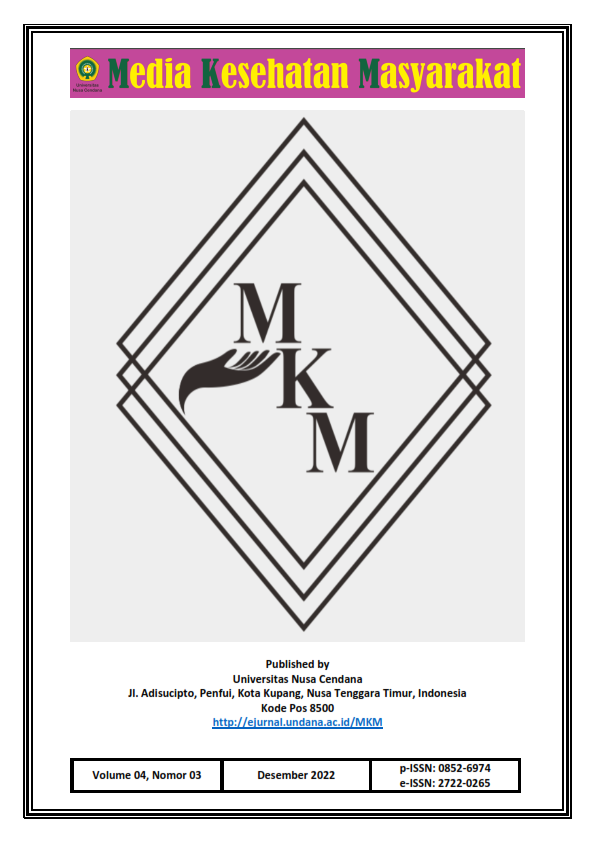Non MKJP Drugs and Devices Contraceptive in Couples of Childbearing Age as Active Family Planning Acceptors in Oesao Health Center
Abstract
The pattern of use of non-MKJP in the community is higher than MKJP contraception, both at the provincial and district/city levels in Indonesia. The use of non-MKJP contraception is prone to failure to prevent pregnancy and the rate of discontinuation. This study aims to examine the use of non-MKJP contraceptive devices and drugs on active family planning acceptors in the working area of the Oesao Health Center. This type of research is qualitative with a case study design. 10 participants were taken by purposive sampling technique. The research instrument was the researcher assisted by in-depth interview guidelines. The results of the interviews were analyzed using thematic study techniques. The results showed that there was a knowledge gap between MKJP and non-MKJP contraception, resulting in misinformation, and the use of non-MKJP contraception was only seen from a positive impact. Non-MKJP contraception facilities are fully available at Pustu and Oesao Health Center and are easily accessible. The remote location of the Oesao Health Center causes acceptors to choose to get non-MKJP contraception services at the Pustu. The cost of non-MKJP contraception is affordable. The decision that is in the hands of the wife makes them use non-MKJP contraception. The support of health workers has not had an impact because acceptors trust information from colleagues about family planning more. It is recommended that health workers actively provide counseling about family planning and involve role models so that mothers who are >35 years old and have >3 children want to use MKJP contraception.
Downloads
References
Syamsul, Bakri B, Limonu Stevany H. Penggunaan Alat KB pada Wanita Kawin di Perdesaan dan Perkotaan (Studi Hasil SDKI 2017 Provinsi Gorontalo). J Kependud Indones [Internet]. 2020;15(1):71–84. Available from: https://ejurnal.kependudukan.lipi.go.id/index.php/jki/article/view/461
BKKBN. Peraturan Kepala Badan Kependudukan dan Keluarga Berencana Nasional Nomor 24 Tahun 2017 Tentang Pelayanan Keluarga Berencana Pasca Persalinan dan Pasca Keguguran [Internet]. BKKBN, 24 Jakarta, Indonesia; 2017. Available from: https://jdihn.go.id/files/241/PERKA 24 2017 KB PPPK.pdf
Kementerian Kesehatan RI. Profil Kesehatan Indonesia 2020 [Internet]. Hardhana B, Sibuea F, Widiantini W, editors. Kementerian Kesehatan RI. Jakarta: Kementerian Kesehatan RI; 2021. 480 p. Available from: https://pusdatin.kemkes.go.id/resources/download/pusdatin/profil-kesehatan-indonesia/Profil-Kesehatan-Indonesia-Tahun-2020.pdf
Puskesmas Oesao. Peserta KB Aktif Menurut Jenis Kontrasepsi, Kecamatan, dan Puskesmas Kecamatan Kupang Timur Tahun 2021. Oesao; 2021.
Triyanto L, Indriani D. Faktor yang Mempengaruhi Penggunaan Jenis Metode Kontrasepsi Jangka Panjang (MKJP) pada Wanita Menikah Usia Subur di Provinsi Jawa Timur. Indones J Public Heal [Internet]. 2018;13(2):244–55. Available from: https://e-journal.unair.ac.id/IJPH/article/view/8174/pdf
Simanjuntak SIR. Determinan Faktor Kejadian Drop Out Kontrasepsi Pil di Kelurahan Pekan Tanjung Morawa Kecamatan Tanjung Morawa Kabupaten Deli Serdang Tahun 2016 [Internet]. Universitas Sumatera Utara. Universitas Sumatera Utara; 2016. Available from: https://repositori.usu.ac.id/handle/123456789/20062
Simorangkir KV. Faktor-faktor yang Mempengaruhi Efektivitas Penggunaan Kontrasepsi Hormonal pada Pasangan Usia Subur (PUS) Akseptor KB Aktif di Puskesmas Sikumana Tahun 2015. Universitas Nusa Cendana; 2015.
Notoatmodjo S. Promosi Kesehatan Teori dan Aplikasi. 3rd ed. Notoadmodjo S, editor. Jakarta: Rineka Cipta; 2018. 321 p.
Silalahi RR, Sevilla V. Rekontruksi Makna Hoaks di Tengah Arus Informasi Digital. Glob Komunika J Ilmu Sos dan Polit [Internet]. 2020;1(1):8–17. Available from: https://ejournal.upnvj.ac.id/index.php/GlobalKomunika/article/view/1722
Priyanti S, Syalfina AD. Buku Ajar Kesehatan Reproduksi dan Keluarga Berencana. 1st ed. Boangmanalu I, editor. Surakarta: Kekata Group; 2017.
Jitowiyono S, Rouf MA. Keluarga berencana (KB) dalam Perspektif Bidan. 1st ed. Yogyakarta: Pustaka Baru; 2019. 210 p.
Setiasih S, Widjanarko B, Istiarti T. Analisis Faktor-faktor yang Mempengaruhi Pemilihan Metode Kontrasepsi Jangka Panjang (MKJP) pada Wanita Pasangan Usia Subur (PUS) di Kabupaten Kendal Tahun 2013. J Promosi Kesehat Indones [Internet]. 2016;11(2):32–46. Available from: https://ejournal.undip.ac.id/index.php/jpki/article/view/19002
Prawirohardjo S. Ilmu Kebidanan. 4th ed. Saifuddin AB, Rachimhadhi T, Wiknjosastro GH, editors. Jakarta: Bina Pusaka Sarwono Prawirohardjo; 2016. 981 p.
Saputra A, Novianti L. Hubungan Ketersediaan Alat Kontrasepsi terhadap Penggunaan Alat Kontrasepsi pada Pasangan Usia Subur. J Kesehat J Ilm Multi Sci [Internet]. 2020;10(2):89–96. Available from: https://jurnal.stik-sitikhadijah.ac.id/index.php/multiscience/article/view/290
Alfiah ID. Faktor Faktor yang Berhubungan dengan Penggunaan Metode Kontrasepsi Jangka Panjang di Wilayah Kerja Puskesmas Kecamatan Kalideres Tahun 2015 [Internet]. UIN Syarif Hidayatullah. UIN Syarif Hidayatullah; 2015. Available from: https://repository.uinjkt.ac.id/dspace/bitstream/123456789/28900/1/ISMI DZALVA ALFIAH-FKIK.pdf
Laurensia L, Mustikawati IS. Faktor-faktor yang Berhubungan dengan Penggunaan Metode Kontrasepsi Jangka Panjang (MKJP). Heal Publica J Kesehat Masy [Internet]. 2020;1(1):34–43. Available from: https://ejurnal.esaunggul.ac.id/index.php/HealthPublica/article/view/3271
Anitasari B, Sarmin. Faktor yang Berhubungan dengan Partisipasi Pria dalam Program Keluarga Berencana di Wilayah Kerja Puskesmas Tanasitolo. J Ilmu Kedokt dan Kesehat Indones [Internet]. 2021;1(3):73–83. Available from: https://journal.amikveteran.ac.id/index.php/jikki/article/view/177
Rahmi AA, Hadi EN. Determinan Pemilihan Implan pada Pasangan Usia Subur di Kecamatan Medan Petisah. Perilaku dan Promosi Kesehat Indones J Heal Promot Behav [Internet]. 2020;2(2):52–8. Available from: https://journal.fkm.ui.ac.id/ppk/article/view/4144
Ratnawati C. Faktor-faktor yang Berhubungan dengan Kurangnya Penggunaan Alat Kontrasepsi Intra Uterine Device di Kecamatan Tinggi Moncong Kabupaten Gowa. UIN Alauddin Makassar; 2019.
Suyati. Pengaruh Dukungan Suami terhadap Ketepatan Kunjungan Ulang Akseptor KB Suntik. Str J Ilm Kesehat [Internet]. 2013;2(2):62–8. Available from: https://sjik.org/index.php/sjik/article/view/56/60
Copyright (c) 2022 Author

This work is licensed under a Creative Commons Attribution-ShareAlike 4.0 International License.

 Rani Setyahadi Karno(1*)
Rani Setyahadi Karno(1*)














